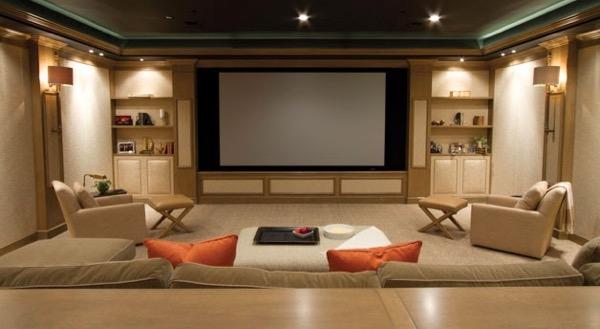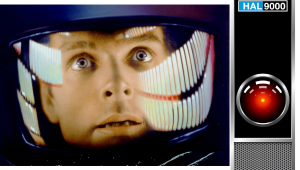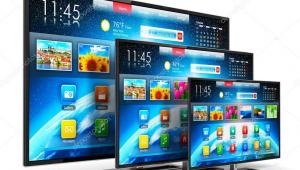UHDTV or UHD Projector?

The TV Option
Most will choose the flat screen Ultra HDTV. And they’ll inevitably buy an Ultra HD set rather than 1080p HD because the time’s now long past when you can find a good 65-inch or larger set that isn’t Ultra HD. And for a home theater, where movies are king, a 65-incher is likely what you’re looking for. Anything less is just a TV. Dream much larger for a flat screen, however, and the choices shrink as dramatically as the prices increase. I’d love to have one of those new 77-inch OLEDs from LG or Sony, but the price would pay for a 65-inch OLED and a true 4K projector and a good, 10-foot wide screen and pay someone to install and calibrate it all! There are a few competitively-priced 80-inch or so flat screen sets out there, but they have to eliminate more than a few key features to reach pocketbook-friendly levels.
What does that 65-inch set offer? Even if it’s budget model, or left over from last year (both of which will likely be featured attractions in the Black Friday feeding frenzy—say that fast three times), it should offer good resolution with the full 8+ million pixels (3840 x 2160) required by a 4K source. It will also upconvert lesser resolutions like 1080p to 3840 x 2160, but while such upconversion has now improved across the board, some sets still do it better than others. We test for upconversion in our reviews using material specifically designed to trip up a display, but even the displays that fail one or more of these tests rarely have obvious issues with normal program sources.
The set will also have advanced color on tap when called for by an Ultra HD input. And if it’s a new, flagship LED/LCD design it should be capable of 1000 nits of peak brightness (292 ft-L), or at least 500 nits if it’s an OLED.
Black level and shadow detail quality will likely vary all over the map from model to model, but if you’ve chosen a OLED, or an LED/LCD with full-array, backlit local dimming, they should be good at the least. Edge-lit local dimming will be a shot in the…um… darksome are OK, others not so much. If the specs or promotional materials just say local dimming with no qualifiers, it’s probably edge lit local dimming. It’s also possible that a bargain set will have no backlight dimming at all, in which case avoid it unless price is the deciding factor. (The more dimming zones the better, particularly for high dynamic range. But I’m still pondering whether or not local dimming in flat panel sets, and dynamic irises on projectors, are optimum solutions when the best possible HDR is required, but that’s a subject for a different blog. For now, they’re useful for achieving decent black levels, which for me is at least as important as unfettered HDR.)
Get that set home and it will take you an hour or so to set up, unless you’re considering a wall mount over the fireplace. (Hint: Don’t). While a good calibration is recommended, particularly if you’ve spent at least three big ones for it, you can start watching right away, even in normal room lighting. Put off any calibration until you’ve put a couple of hundred hours on the set (the same recommendation is valid for a projector as well).
Be aware that any UHDTV you buy today (early November 2017) is now half way to reaching its sell-by date; new models will be shown at the annual CES in January and start appearing in stores in the spring of 2018. As print reviewers, we’re now entering the annual TV dead zone; if I receive a TV today, and take three weeks to live with and review it (which I preferthough sometimes don’t get!), by the time the editing, printing, and mailing are complete, knowledgeable buyers will have read our CES reports and be aware of what will hit the stores in a couple of months.
That’s why TV prices tend to be at their highest right after their spring and summer introductions (plus the fact that there are fewer buyers who are thirsting after the latest TV in the summer).
TVs don’t change much from year to year. They’re refreshed every year, but major changes only come when some new wrinkle is introduced, like 3D or 4K. The latter is just reaching heavy market penetration, and we don’t anticipate any explosive new feature anytime soon (like 8K—lord help us all!). But we could be wrong. One possible exception could be a further drop in OLED prices over the next few years. The point here is that waiting for the next big thing can be a fool’s errand. I had an uncle who once waited to buy a color TV until they were “perfected.” If there’s a Best Buy in heaven, he’s likely still waiting.
Projector Pros & Cons
But if you want a projector for that really big screen experience, it can be had for the price of a high-end, 65-inch flat screen set. Most of the issues addressed above apply to projectors as well. Projectors are more difficult to deal with, however, and have some shortcomings compared to a UHDTV. We assume here you’re looking for Ultra HD in your projector, or something “close to that.” There are still plenty of affordable models out there that top out at 1080p. Not that there’s anything wrong with that, but just be sure you get what you’re looking for.
The “close to that” modifier above is the first item on the decision menu. There’s only one projector on the market as of the end of 2017, at a price many of us can at least aspire to, that puts the full 8+ million pixels in each frame of a 4K source on the screen at the same time. It’s Sony’s new VPL-VW285ESan impressive piece to be sure but it’s still $5000 and the screen, as with all projectors, is a separate expense.
There are less expensive projectors on the market that will accept a 4K source and project it, though they use a form of pixel-shifting to provide a picture that approaches full 4K. Their imaging chips don’t have 8+ million pixels. But despite that some of them might actually challenge a full 4K design in some respects (like brightness, color, and/or black level), so they shouldn’t be dismissed out of hand.
A projection setup also needs a degree of dedication that flat screen sets don’t. It requires a blacked-out room for best results. Ideally the rest of the room will be decorated in any color as long as it’s blackcarpets, walls, ceiling, etc., but that’s obsessive and not mandatory for folks that don’t have a separate room for exclusive use as a home theater. Even those who do, but also use their system to listen to music without pictures, might find that a blacked-out cave isn’t the best environment for that experience (though there’s something to be said for listening to music in the dark!).
If you also need to use the room for other purposes it’s not usually possible to go 100% of the way with a projection setup. But I’d recommend a retractable screen to get it up and out of the way when not in use. They’re generally pricier than the fixed frame variety, but a flood of new screen manufacturers have sprung up in recent years to challenge market veterans such as Stewart, Da-Lite, and Draper, making prices more competitive.
Many of these relative newbie companies also offer light rejecting screens that can help if you don’t have full light control (not all of these are retractable, so be careful there if that’s what you want). But they’re expensive and, while their makers might disagree, in my opinion there’s still there’s no substitute for watching movies in a fully darkened room. Sports are a different issue, and since they’re invariably brightly lit throughout, some room lighting (but not direct sunlight) should work well with such screensor even on traditional screens though with some visible fading.
My reviewing room has dark gray (but not black) carpet, medium beige walls, and a white ceiling (fortunately over 8-feet high). Someday I might paint the ceiling black, but that’s not in my immediate plans. And I’m not at all unhappy with the image quality I get from good projectors and a traditional screenas long as the room is fully dark. But what about those picture’s you see on-line and in-print, of a bright room with a vivid image on a big screen? For most of them, Photoshop is their daddy. They’re not a cheat; that’s the only way to show the room décor with a good image on the screen. But it’s not real.
There are no consumer displays of any sort that can do everything that Ultra HD, in high dynamic range (HDR) offersat least not yet. But projectors are more limited than flat screen sets in how close they get to it. The biggest shortcoming of all projectors is their peak brightness capability. I’ve yet to test a UHD projector that can exceed roughly 170 nits (about 50 foot-lamberts). Many are closer to 125 nits. Even a budget flat screen set can likely exceed 300 nits, and some can exceed 1500. But as with our hearing, human vision isn’t linear; 350 nits doesn’t look even close to twice as bright as 175. And in a darkened room it takes a lot less peak brightness than you might think to produce a rewarding dose of HDR.
Projectors can also produce a respectable taste of Ultra HD’s advanced color, but they’re limited because of their light sourcea projection lamp. Laser illumination can do much better, but is expensive to implement. The “cheapest” full 4K projector we know of that uses laser lighting is a $25,000 Sony. Some projectors add filters to the light path to enhance color, but this can reduce brightness. The color wheel typically used in single-chip DLP designs can also limit color. But since no affordable display technology (or source material) can yet achieve the supposed Holy Grail of UHD color (the BT.2020 color gamut), and those I’ve seen can at least exceed the HD color gamut (BT.709) with a UHD source, this is, in my opinion, the least important of a projector’s UHD limitations.
Projection lamps also fade with age, and will eventually need to be replaced. How long that will take depends on a lot of factors, but if you use the projector as your main display you might start thinking about replacing the lamp after 3 years or soless if you’re hypercritical. And since new lamps aren’t cheap averaging $300 to $400, that’s not a minor consideration. And if power saving is your thing, projectors use more power than a typical LED/LCD set, though less than old-timey plasmas.
Virtually all UHDTVs also have built-in apps for streaming video from popular sites like Netflix, Hulu, Amazon, and Vudu. Projectors don’t. You’ll have to pay extra to add a device such as AppleTV if streaming is important to you.
And while 3D is fast fading into the rear-view mirror on flat screen sets, many projectors (but not all) still offer it.
Best of Both Worlds
There are other considerations that enter into the desirability of any given display’s suitability for Ultra HD, including the bandwidth (bit rate) it can accept and pass through to the image on the screen. But those are subjects for full reviews, or a search of this site, where you’ll find, for example, detailed features on screens and other subjects that will help you make your decision. And that decision will ultimately be personal. You might even elect to scratch by with both a projector for movie nights with a drop-down screen, and a flat screen set behind it for more casual viewing. Is that obsessive? Nah. That’s what I use, but then I sort of have to!





























































